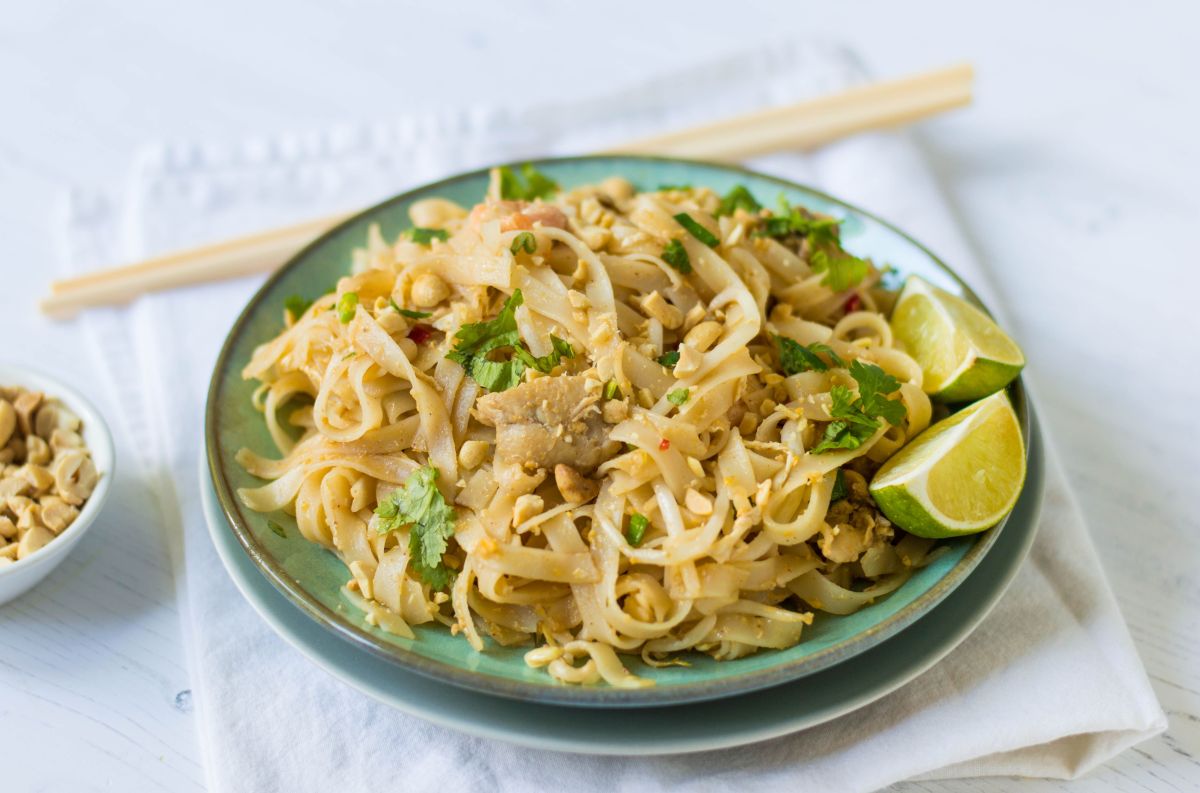Embark on a culinary journey through Thailand, where vibrant flavors explode on your palate without a single nut in sight! This collection unveils the secrets to crafting authentic Thai dishes, bursting with the aromatic spices and fresh ingredients that define Thai cuisine. Discover how to skillfully substitute ingredients, maintaining the creamy textures and rich depths of flavor you crave, all while catering to nut allergies or preferences. Prepare to be amazed by the versatility of Thai cooking and the delicious possibilities that await.
We’ll explore the core ingredients that provide that unmistakable Thai punch, deconstruct classic dishes to reveal their nut-free potential, and guide you through step-by-step recipes, complete with stunning visuals. From the fiery heat of a green curry to the delicate balance of a fragrant soup, we’ll cover a spectrum of flavors and techniques, ensuring you can confidently create a delightful nut-free Thai feast.
Authentic Thai Flavors Without Nuts

Unlocking the vibrant tapestry of Thai cuisine doesn’t require nuts; a symphony of flavors awaits, ready to tantalize your taste buds without relying on these ingredients. This exploration delves into the heart of authentic Thai taste, revealing the key components and techniques that create dishes bursting with the characteristic zest and complexity.
Five Key Ingredients for Authentic Nut-Free Thai Flavor
The foundation of authentic Thai cuisine lies in a harmonious blend of fresh ingredients. These five key components, readily available and easily incorporated, provide the depth and complexity typically associated with nut-based dishes. Their interplay delivers a captivating culinary experience without the need for nuts.
- Lemongrass: Its bright, citrusy aroma and subtle lemony flavor add a refreshing zing, cutting through richness and providing a vibrant lift to curries and soups.
- Galangal: A close relative of ginger, galangal offers a more pungent, subtly camphoraceous flavor that adds depth and warmth to dishes, particularly curries and stir-fries.
- Kaffir Lime Leaves: These aromatic leaves impart a unique citrusy fragrance and a slightly bitter, floral note, adding complexity and a touch of sophistication.
- Thai Chillies: From fiery bird’s eye chillies to milder varieties, these bring the heat and a vibrant, spicy kick that is essential to many Thai dishes.
- Fish Sauce: This savory, umami-rich condiment provides a salty, pungent base note, balancing sweetness and acidity, and adding depth to a wide range of dishes.
Three Variations of Nut-Free Thai Curry Paste
Mastering the art of Thai curry paste unlocks a world of flavor possibilities. These three variations showcase the versatility of nut-free options, each offering a distinct and captivating flavor profile. The vibrant colors and intense aromas hint at the culinary journey ahead.
- Green Curry Paste: A vibrant green paste, alive with the freshness of cilantro, green chilies, lemongrass, and galangal. Imagine a vivid emerald hue, speckled with flecks of green chili. The aroma is intensely fragrant, a heady mix of citrus, spice, and herbs.
- Red Curry Paste: A deep crimson paste, rich with the intensity of red chilies, shallots, garlic, lemongrass, and galangal. Picture a rich, almost ruby-red color, with hints of orange from the spices. The aroma is bold and complex, a captivating blend of heat and aromatic spices.
- Yellow Curry Paste: A sunny yellow paste, infused with the warmth of turmeric, lemongrass, galangal, and a touch of sweetness from shallots and garlic. Envision a golden yellow hue, almost buttery in appearance. The aroma is inviting and comforting, a blend of warm spices and subtle sweetness.
Nut-Free Equivalents for Common Thai Dishes
Many classic Thai dishes traditionally incorporate nuts, but delicious alternatives exist. These substitutions preserve the authenticity and characteristic flavors, offering a nut-free enjoyment of these beloved recipes.
- Peanut Sauce: Instead of peanuts, use a vibrant blend of sunflower seed butter or tahini, combined with lime juice, fish sauce, brown sugar, and garlic for a rich, savory sauce.
- Massaman Curry: Replace peanuts with roasted sunflower seeds for a similar textural element and a subtle nutty flavor in this rich, aromatic curry. The sunflower seeds should be finely ground or pureed.
- Satay Sauce: Opt for a smooth, creamy sauce made from blended cashews, substituting it with a creamy blend of roasted and pureed pumpkin seeds, seasoned with turmeric, lemongrass, and a touch of coconut milk for a similar rich, nutty flavor.
- Thai Green Curry: While peanuts aren’t typically used in green curry, some recipes include them. The authentic flavors of green curry are best preserved by simply omitting the peanuts entirely. The vibrant mix of herbs and spices provides ample flavor.
- Pad Thai: The traditional Pad Thai often uses crushed peanuts for garnish. To create a nut-free version, simply omit the peanuts, or substitute with toasted sesame seeds for a subtle nutty flavor and textural contrast.
Visual Guide to Nut-Free Thai Cooking
This section provides a detailed visual journey through the preparation of three popular nut-free Thai dishes, highlighting the color, texture, and consistency changes at each stage. We’ll explore the vibrant transformation of ingredients as they are expertly combined to create authentic Thai flavors without the use of nuts.
Nut-Free Pad Thai Preparation
The journey begins with a medley of colorful ingredients: bright orange carrots julienned into thin, delicate strips; vibrant green bean sprouts, crisp and fresh; and the deep crimson of sun-dried tomatoes adding a touch of sweetness and acidity. These are tossed with rice noodles, initially pale ivory, that gradually absorb the sauce and become translucent and glossy. The addition of the savory soy sauce deepens the color to a rich amber, while the vibrant green of scallions adds a final touch of freshness. The eggs, initially clear and runny, transform into a soft, golden scramble, intertwining with the noodles. The finished Pad Thai is a harmonious blend of colors and textures, with a glistening, slightly sticky consistency.
Nut-Free Thai Red Curry Plating and Presentation
A perfectly plated nut-free Thai red curry is a feast for the eyes. The rich, vibrant crimson of the curry sauce, thick and luscious, forms a pool in the center of the plate, its surface shimmering with a gentle sheen from the coconut milk. Tender pieces of chicken or tofu, cooked to perfection, are nestled within the sauce, their pale color contrasting beautifully with the deep red. A scattering of bright green cilantro leaves adds a pop of freshness, while slivers of red chili, providing a visual hint of spice, are strategically placed around the dish. The final touch is a garnish of finely chopped scallions, their green adding a layer of visual texture to the overall composition. The plate itself should be simple and elegant, allowing the vibrant colors of the curry to take center stage.
Nut-Free Thai Salad Cooking Process
The preparation of a nut-free Thai salad begins with a vibrant array of fresh ingredients: the deep green of crisp lettuce leaves, the ruby red of cherry tomatoes, halved to reveal their juicy interiors, and the vivid orange of shredded carrots, adding a touch of sweetness. The addition of the vibrant green of fresh herbs – mint, cilantro, and basil – further enhances the visual appeal. The dressing, a mixture of lime juice, fish sauce, and sugar, is initially pale and translucent, but as it’s tossed with the vegetables, it coats them in a glossy sheen, enhancing their natural colors. The final product is a stunning display of colors and textures, a vibrant and refreshing salad that is as pleasing to the eye as it is to the palate. The subtle variations in color and texture, from the crispness of the lettuce to the softness of the herbs, create a visually captivating experience.
Exploring Diverse Nut-Free Thai Cuisine
Thailand’s vibrant culinary landscape offers a wealth of delicious dishes that are naturally nut-free, showcasing the country’s diverse regional flavors and ingredients. This exploration delves into three distinct regions, highlighting unique nut-free specialties, and then introduces five lesser-known dishes with detailed recipes.
Regional Variations in Nut-Free Thai Cuisine
Thailand’s diverse geography and cultural influences result in distinct regional culinary styles. The following showcases three regions and their characteristic nut-free dishes.
Northern Thailand: Known for its mountainous terrain and Lanna cultural heritage, Northern Thai cuisine often incorporates ingredients like chilies, herbs, and fermented foods. The region’s unique flavor profiles are less reliant on nuts than other parts of the country.
- Khao Soi (without peanuts): A rich and creamy coconut milk-based curry noodle soup, traditionally including peanuts. However, a delicious nut-free version can be made by simply omitting the peanuts and boosting the flavor with additional spices like galangal and turmeric. The broth, a vibrant orange-yellow, is fragrant with lemongrass and kaffir lime leaves. The soft, egg noodles are coated in a luscious coconut milk sauce, complemented by tender chicken or beef, and topped with pickled mustard greens for a refreshing contrast.
- Sai Oua (Northern Thai sausage): This flavorful sausage is made with finely ground pork, lemongrass, galangal, and chilies, resulting in a spicy and aromatic sausage that is completely nut-free. Its texture is coarse and slightly chewy, offering a satisfying bite. The intense herbal aromas are immediately apparent, and the taste is both savory and spicy, with a hint of sweetness from the lemongrass.
- Gaeng Hung Lay (Northern Thai pork curry): This curry is characterized by its rich, dark brown color from the use of tamarind and soy sauce. It features tender pieces of pork slow-cooked until meltingly soft, alongside vibrant green vegetables. The aroma is earthy and complex, with a subtle sweetness from the tamarind balancing the savory pork and spices. The texture is a delightful combination of tender pork and crisp vegetables.
Central Thailand: The heart of Thailand, this region boasts a diverse range of dishes reflecting the country’s rich culinary heritage. Central Thai cuisine tends towards balance and harmony of flavors.
- Tom Yum Soup (without peanuts): A classic spicy and sour soup, traditionally made with lemongrass, galangal, kaffir lime leaves, and chilies. The iconic Tom Yum flavor profile relies heavily on these aromatic herbs and spices, and doesn’t require nuts. The broth is bright and vibrant, a beautiful clear orange-red. The aroma is intensely fragrant and pungent, a testament to the potent herbs used. The taste is a complex interplay of sour, spicy, and savory notes.
- Pad See Ew (without peanuts): Wide rice noodles stir-fried with soy sauce, Chinese broccoli, and your choice of protein. The key to a great Pad See Ew is the perfectly wok-tossed noodles with a slight char. The noodles have a soft, chewy texture, coated in a savory soy sauce-based sauce. The aroma is deeply savory and slightly smoky from the wok. The taste is balanced and umami-rich.
- Massaman Curry (without peanuts): While Massaman curry often incorporates peanuts, the base of the curry paste can easily be adapted to be nut-free, emphasizing the other complex spices. The result is a rich and aromatic curry with a delightful balance of sweet, savory, and spicy flavors. The creamy texture comes from coconut milk, and the aroma is a complex blend of spices, including cardamom, cinnamon, and cloves.
Southern Thailand: Southern Thailand’s cuisine is heavily influenced by Malay flavors, resulting in dishes that are often richer and spicier than those from other regions. Many traditional dishes are naturally nut-free.
- Green Curry (without peanuts): A vibrant green curry, made with green chilies, coconut milk, and a variety of vegetables. The intense green color comes from the abundance of green chilies, while the coconut milk provides a rich and creamy texture. The aroma is fresh and vibrant, with a distinct chili heat. The taste is intensely flavorful, with a balanced sweetness from the coconut milk and a powerful spiciness from the green chilies.
- Rendang (without peanuts): This rich and flavorful slow-cooked meat curry is traditionally made with beef, but can be adapted to include chicken or other proteins. The long cooking time results in a tender and flavorful meat. The rich, dark brown color comes from the long cooking process and the use of spices. The aroma is deeply savory and fragrant, and the taste is rich and complex, with a subtle sweetness and a warming spiciness.
- Khantoke (without peanuts): A traditional Northern Thai meal served on a Khantoke, a low circular wooden tray. While Khantoke often includes various dishes, many can be made nut-free, focusing on flavorful curries and grilled meats.
Five Lesser-Known Nut-Free Thai Dishes
These dishes showcase the hidden depths of Thai cuisine, proving that deliciousness doesn’t rely on nuts.
1. Pla Nueng Manow (Steamed Fish with Lime Sauce):
Ingredients: 1 whole fish (sea bass or snapper), 2 limes (juice and zest), 2 shallots (thinly sliced), 2 cloves garlic (minced), 1-2 Thai chilies (finely chopped), 1 tbsp fish sauce, 1 tsp sugar, fresh cilantro.
Instructions: Clean and steam the fish until cooked through. In a bowl, whisk together lime juice, zest, shallots, garlic, chilies, fish sauce, and sugar. Pour sauce over the steamed fish and garnish with cilantro.
A perfectly steamed fish should be flaky and moist, with a delicate texture.
2. Yam Tua Plu (Winged Bean Salad):
Ingredients: 1 cup winged beans (trimmed and thinly sliced), 1/2 cup cherry tomatoes (halved), 1/4 cup red onion (thinly sliced), 2 tbsp lime juice, 1 tbsp fish sauce, 1 tsp sugar, 1-2 Thai chilies (finely chopped), fresh mint leaves.
Instructions: Combine all ingredients in a bowl and toss gently. Let the salad sit for 10-15 minutes to allow the flavors to meld.
The key is to use fresh, high-quality ingredients. The winged beans should be crisp and vibrant.
3. Gaeng Som Pla (Sour Fish Curry):
Ingredients: 1 lb firm white fish fillet (cut into chunks), 1 cup tamarind pulp (dissolved in 1 cup water), 1 cup water, 2 tbsp fish sauce, 1 tbsp palm sugar, 1 stalk lemongrass (bruised), 2 kaffir lime leaves, 1 red chili (sliced), 1/2 cup Thai eggplant (sliced), 1/4 cup long beans (cut into 1-inch pieces).
Instructions: Combine tamarind water, water, fish sauce, palm sugar, lemongrass, and kaffir lime leaves in a pot. Bring to a boil, then add fish and vegetables. Simmer until fish is cooked and vegetables are tender. Add chili before serving.
The tamarind provides a wonderfully sour and tangy base for the curry.
4. Pad Prik Khing (Stir-fried Ginger Chicken):
Ingredients: 1 lb boneless, skinless chicken breasts (cut into bite-sized pieces), 1/2 cup ginger (finely chopped), 3 cloves garlic (minced), 2-3 Thai chilies (finely chopped), 2 tbsp soy sauce, 1 tbsp fish sauce, 1 tbsp oyster sauce, 1 tbsp vegetable oil.
Instructions: Stir-fry chicken until cooked through. Add ginger, garlic, and chilies; stir-fry for 1 minute. Add soy sauce, fish sauce, and oyster sauce. Stir-fry until sauce thickens.
The key to this dish is the intense ginger flavor. Don’t be shy with the ginger!
5. Tom Kha Gai (Coconut Soup without Peanuts):
Ingredients: 1 lb boneless, skinless chicken breasts (cut into bite-sized pieces), 4 cups coconut milk, 1 stalk lemongrass (bruised), 2 kaffir lime leaves, 1 inch galangal (sliced), 2-3 Thai chilies (sliced), 1 tbsp fish sauce, 1 tsp sugar, fresh cilantro (for garnish).
Instructions: Combine all ingredients except cilantro in a pot. Bring to a simmer and cook until chicken is cooked through. Garnish with cilantro before serving.
The richness of the coconut milk is balanced by the aromatic herbs and spices.
Unlocking the vibrant world of nut-free Thai cooking is easier than you might think. With a little creativity and the right techniques, you can effortlessly recreate the magic of Thailand in your own kitchen, without compromising on flavor or authenticity. This guide has equipped you with the knowledge and recipes to confidently navigate the exciting world of nut-free Thai cuisine, empowering you to create dishes that are both delicious and inclusive. So, gather your ingredients, embrace the adventure, and prepare to delight your taste buds with the vibrant symphony of flavors that await!
Key Questions Answered
Can I freeze nut-free Thai curries?
Yes, nut-free Thai curries freeze well. Allow them to cool completely before storing in airtight containers for up to 3 months.
What are good substitutes for coconut milk in Thai dishes?
While coconut milk is a staple, you can experiment with full-fat coconut cream for richer dishes, or use cashew cream (for those not avoiding nuts) or even silken tofu for a lighter alternative.
Are all Thai sauces nut-free?
No, many traditional Thai sauces, particularly peanut sauce, contain nuts. Always check ingredient lists carefully.
How can I thicken a nut-free Thai soup?
Use a cornstarch slurry (mix cornstarch with cold water), or simmer with a little rice flour to achieve the desired consistency.


